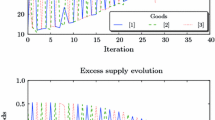Abstract
In this paper, we present an interior-point path-following algorithm for computing a Leontief economy equilibrium, that is, an exchange market equilibrium with Leontief utility functions, which is known to be in the complexity class of PPAD-complete. It is known that an equilibrium corresponds to a solution of a system of complementarities, so we construct a smooth homotopy interior-point path to tackle this system. We prove that there always exists a continuously differentiable path leading to a complementary solution of the nonlinear system and at the same time to a Leontief economy equilibrium associated with the solution. We also report preliminary computational results to show effectiveness of the path-following Newton method.
Similar content being viewed by others
References
Arrow, K., Debreu, G.: Existence of an equilibrium for competitive economy. Econometrica 22, 265–290 (1954)
Brainard, W., Scarf, H.: How to compute equilibrium prices in 1891. Cowles Foundation Discussion Paper 1270 (2000)
Chen, X., Deng, X.: Settling the complexity of two-player Nash equilibrium. In: Proceedings of the 47th Annual IEEE Symposium on Foundations of Computer Science, pp. 261–272 (2006)
Chen, X., Deng, X., Teng, S.: Computing Nash equilibria: approximation and smoothed complexity. In: Proceedings of the 47th Annual IEEE Symposium on Foundations of Computer Science, pp. 603–612 (2006)
Codenotti, B., Saberi, A., Varadarajan, K., Ye, Y.: Leontief economies encode nonzero sum two-player games. In: SODA Theor. Comput. Sci. (2006)
Cottle, R., Pang, J.S., Stone, R.E.: The Linear Complementarity Problem. Academic Press, Boston (1992)
Daskalakis, C., Goldberg, P.W., Papadimitriou, C.H.: The complexity of computing a Nash equilibrium. In: Proceedings of the 39th Annual ACM Symposium on Theory of Computing, pp. 71–78 (2006)
Eaves, B.C., Schmedders, K.: General equilibrium models and homotopy methods. J. Econ. Dyn. Control 23, 1249–1279 (1999)
Garcia, C.B., Zangwill, W.I.: Pathways to Solutions, Fixed Points, and Equilibria. Prentice-Hall, Englewood Cliffs (1981)
Gilboa, I., Zemel, E.: Nash and correlated equilibria: some complexity considerations. Games Econ. Behav. 1, 80–93 (1989)
Golub, G.H., Loan, C.F.V.: Matrix Computations. The Johns Hopkins University Press, Baltimore (1996)
Lemke, C.E.: On complementary pivot theory. In: Dantzig, Veinott (eds.) Mathematics of Decision Sciences, Part 1, pp. 95–114. American Mathematical Society, Providence (1968)
Tsaknakis, H., Spirakis, P.: An optimization approach for approximate Nash equilibria. Lect. Notes Comput. Sci. 4858, 42–56 (2007)
Walras, L.: Elements of Pure Economics, or the Theory of Social Wealth (1874) (1899, 4th edn.; 1926, rev edn., 1954, Engl. Transl.)
Ye, Y.: A path to the Arrow-Debreu competitive market equilibrium. Math. Program. Ser. B 111, 315–348 (2008)
Ye, Y.: Exchange market equilibria with Leontief’s utility: freedom of pricing leads to rationality. Theor. Comput. Sci. 378(2), 134–142 (2007)
Zhu, Z., . Dang, C., Ye, Y.: A FPTAS for computing a symmetric Leontief competitive economy equilibrium. Math. Program. (2010). doi:10.1007/s10107-010-0348-8
Author information
Authors and Affiliations
Corresponding author
Additional information
Research supported in part by GRF CityU 113308 of the Government of Hong Kong SAR, NSF grant DMS-0604513, and NSF GOALI Grant 0800151.
Rights and permissions
About this article
Cite this article
Dang, C., Ye, Y. & Zhu, Z. An interior-point path-following algorithm for computing a Leontief economy equilibrium. Comput Optim Appl 50, 223–236 (2011). https://doi.org/10.1007/s10589-010-9332-8
Received:
Published:
Issue Date:
DOI: https://doi.org/10.1007/s10589-010-9332-8




